Contents
Introduction
Hello, my name is Kinoshita(https://twitter.com/keigo_ashiki), and I am a third-year technical staff member of the University of Tokyo’s Athletic Association A-Shiki Kickball Club. In this article, I would like to introduce the activity cycle of our club’s technical unit, as well as give a detailed introduction to “real-time analysis,” which we have recently started working on and are getting on track.
Since the 2018 World Cup in Russia, the rules of the game have been revised to allow the use of communication devices on the bench. As a result, managers, coaches, and analysts all over the world are now able to check video and data in real time during matches, and the importance of how to utilize technology, which is evolving at a tremendous speed, and link it to victory has become more important.
In particular, the development of quantitative analysis (analysis using data) has been remarkable, and in addition to basic stats such as the number of shots and the percentage of possession, higher-level data such as xG and other data that get to the essence of the game are now available in real time, and it can be said that quantitative analysis is becoming increasingly important.
On the other hand, in the world of university soccer, the Tokyo Metropolitan University League, to which our club belongs, has been allowed to bring communication terminals to the benches, making it theoretically possible to provide real-time feedback in the same way as professionals. However, there is a big gap between what is theoretically possible and what is practicable, and because amateurs lack both human and financial resources, even qualitative analysis such as formation, meshing, and positioning, not to mention quantitative analysis, is often limited to a few people on the bench, such as the manager and coach. In many cases, the coach or manager is the only person on the bench who can perform such qualitative analysis.
In order to break out of this situation, and to gain as many points as possible in the league, our Technical Unit decided to start with qualitative analysis in real time, which is a lower hurdle. In the game of soccer, there is no timeout rule like in basketball or table tennis, and the winner is largely determined by how much the game can be corrected in the very limited 15 minutes of halftime. Therefore, “what to find and what to tell” is very important, and I believe that I can contribute greatly to the team in this area.

Technical Unit Analysis Cycle
The Technical Unit is one of several units in our department, including the Promotion Unit, which aims to attract sponsors, and the Strengthening Unit, which invited former J-League coach Ryohei Hayashi this season. It was established in 20101. Under the strong backing of Mr. Ken Sugisaki, who has been active as a professional soccer analyst for a long time and contributed to Yokohama F. Marinos winning the J-League championship, and who was appointed as a technical advisor to the club this season, a total of 19 dedicated staff members are working on the team from off the pitch, mainly in terms of tactics. A total of 19 dedicated staff members support players, coaches, and managers, mainly in terms of tactics, from off the pitch. Among the many activities of the Technical Unit, I would like to explain the main activity of the Technical Unit, which is the analysis cycle consisting of three phases for each league game.
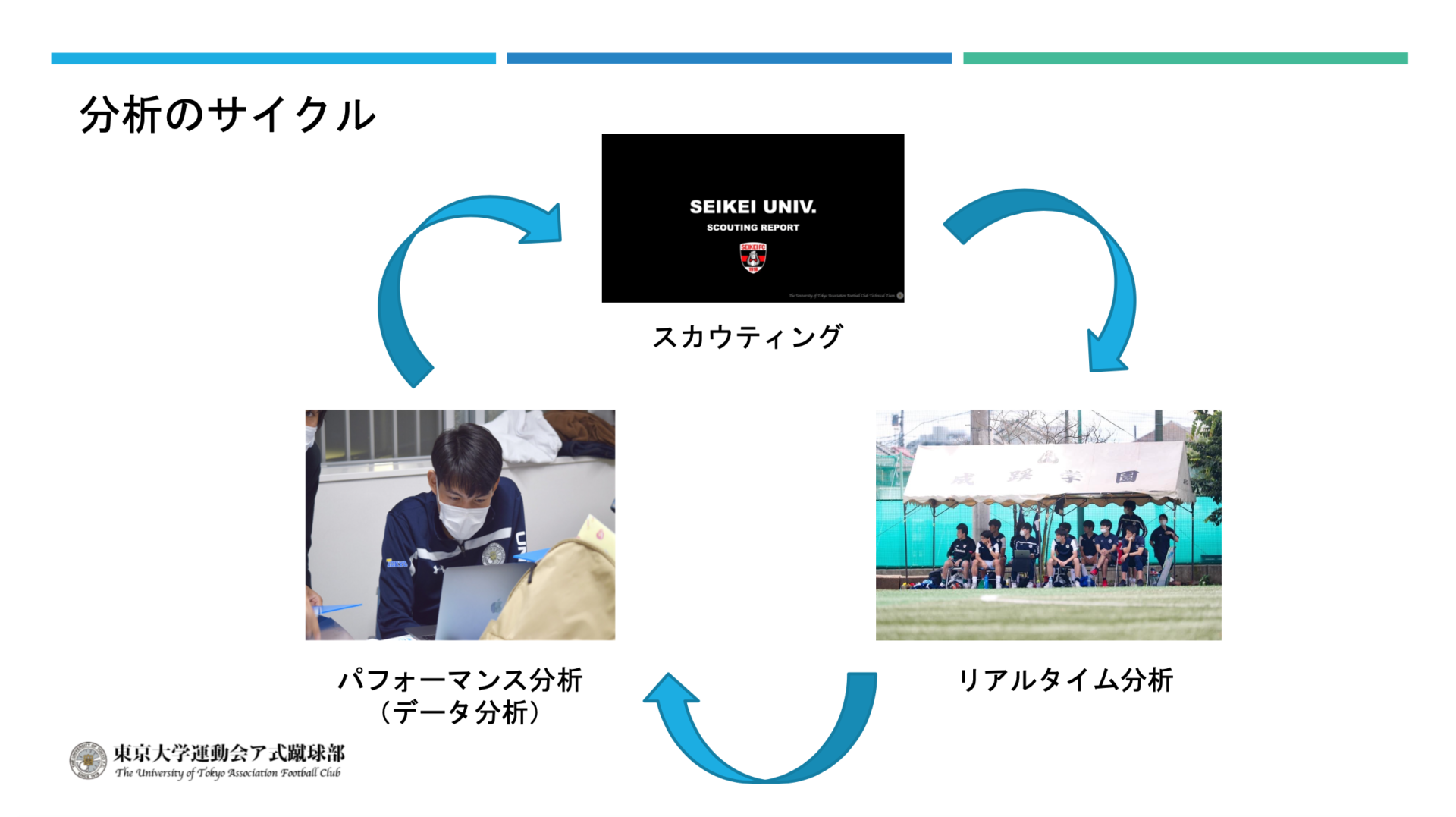
The first thing we do before a match is to analyze and scout the opponent. 3 or 4 scouting teams are formed, and the members of the team in charge watch video footage of the opponent’s match about 2 weeks before the match. The scouting team members in charge will watch the match footage of the opponents about two weeks prior to the match to thoroughly analyze each phase of the match, including set plays, and the characteristics of individual players, and exchange opinions with the coach and manager to help determine the game plan. Then, we share with the players a document that summarizes the opponent’s weaknesses and countermeasures created according to our game model, and present it to them.

On the day of the match, real-time analysis is conducted at kickoff. As the game progresses, a large number of technical staff members analyze the data in real time and provide feedback to the bench.
Performance analysis (data analysis) is conducted within a few days after the game, and mainly uses two tools, Hudl and CATAPULT. In the process of data collection, data calculation and visualization, and feedback, we analyze the performance by actively using various data and comparing it with the video. There are articles and videos (and related articles) that explain the analysis method in detail, so if you are interested, please click on the links below.
Real-time analysis
Here is the main topic. Here are the details of the real time analysis that the technical unit is actually trying to do.
Application to use: FL-UX
EDGE’s FL-UX application is used for analysis. This application enables tagging, drawing, and sharing of video, and has been introduced by professional clubs such as Shonan Bellmare. You can create your own original tags in line with your team’s game model and qualitative analysis views, and then upload the game footage you have shot and tag the scenes you are interested in. You can then later look back at the relevant scene for each tag attached, draw a picture to emphasize what you want to say in that scene, or create a playlist. Playlists can also be downloaded so that the video can be reviewed even in an offline environment. With these features, we use it a lot for scouting as well.
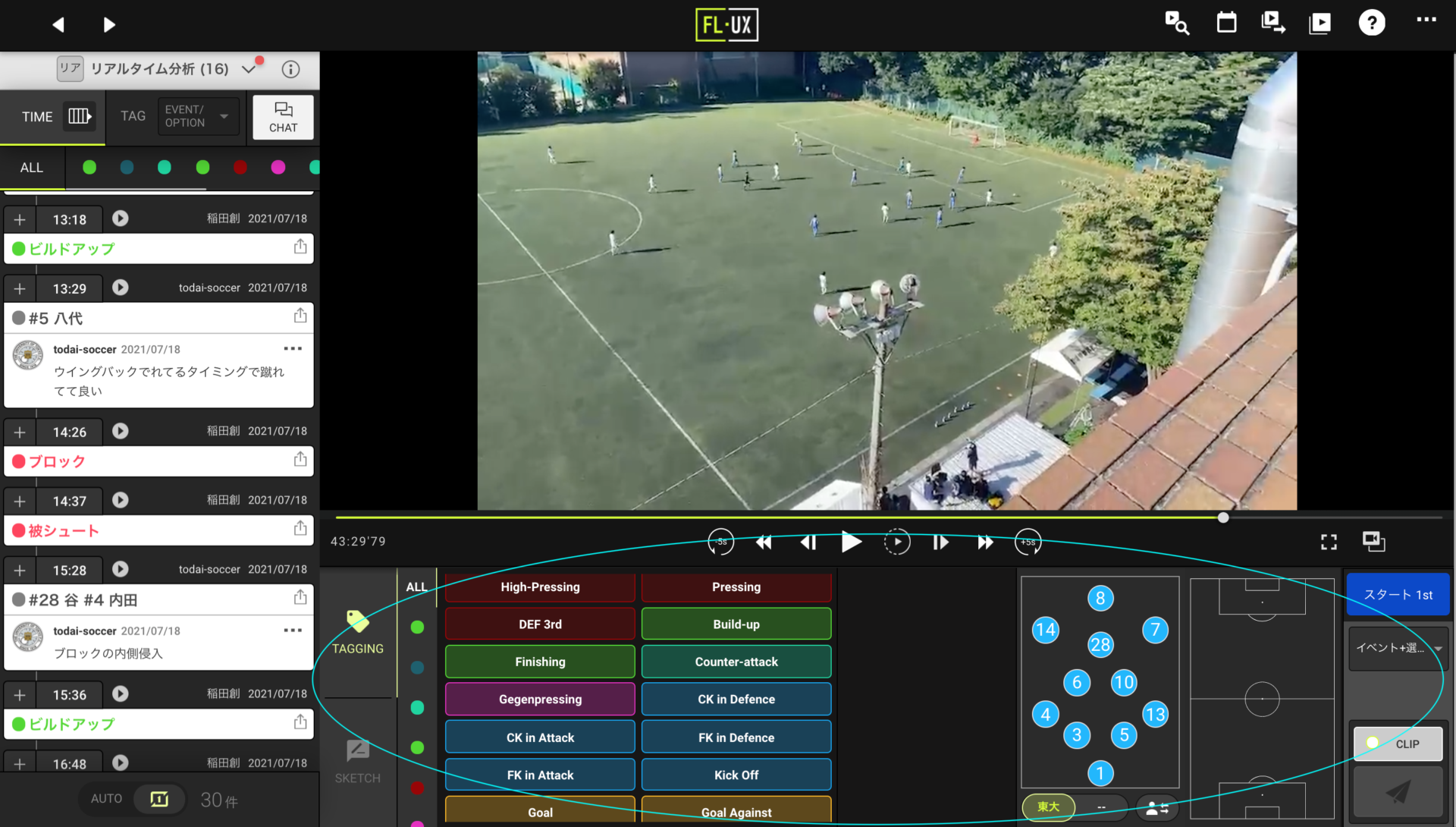
This is the actual tagging screen. As you can see in the blue circle, you can add tags that you have created in advance. Tags include “high press,” “build-up,” “corner kick,” and so on. In addition to tags for each phase, you can also provide tags for individual players.
These tags are instantly shared in the cloud if you are online. As mentioned at the beginning of this article, the Tokyo University League, to which our team belongs, has lifted the ban on bringing communication terminals to the bench, which was previously prohibited. Therefore, through FL-UX, it is possible to provide feedback using real-time video.
role-sharing
①video recording
The match video is captured through the FL-UX app. The live video can be viewed on the terminals of each of the other technical staff. This will be done by about two people, divided into first and second halves.
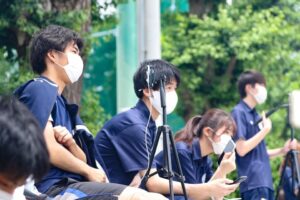
②Tagging
This is where we mobilize as many technical staff as possible. At times, as many as six or seven technical staff members will split up to analyze and tag the scenes, following instructions from the bench. We often add a brief comment to each scene to help the technical staff on the bench sort out the scenes.
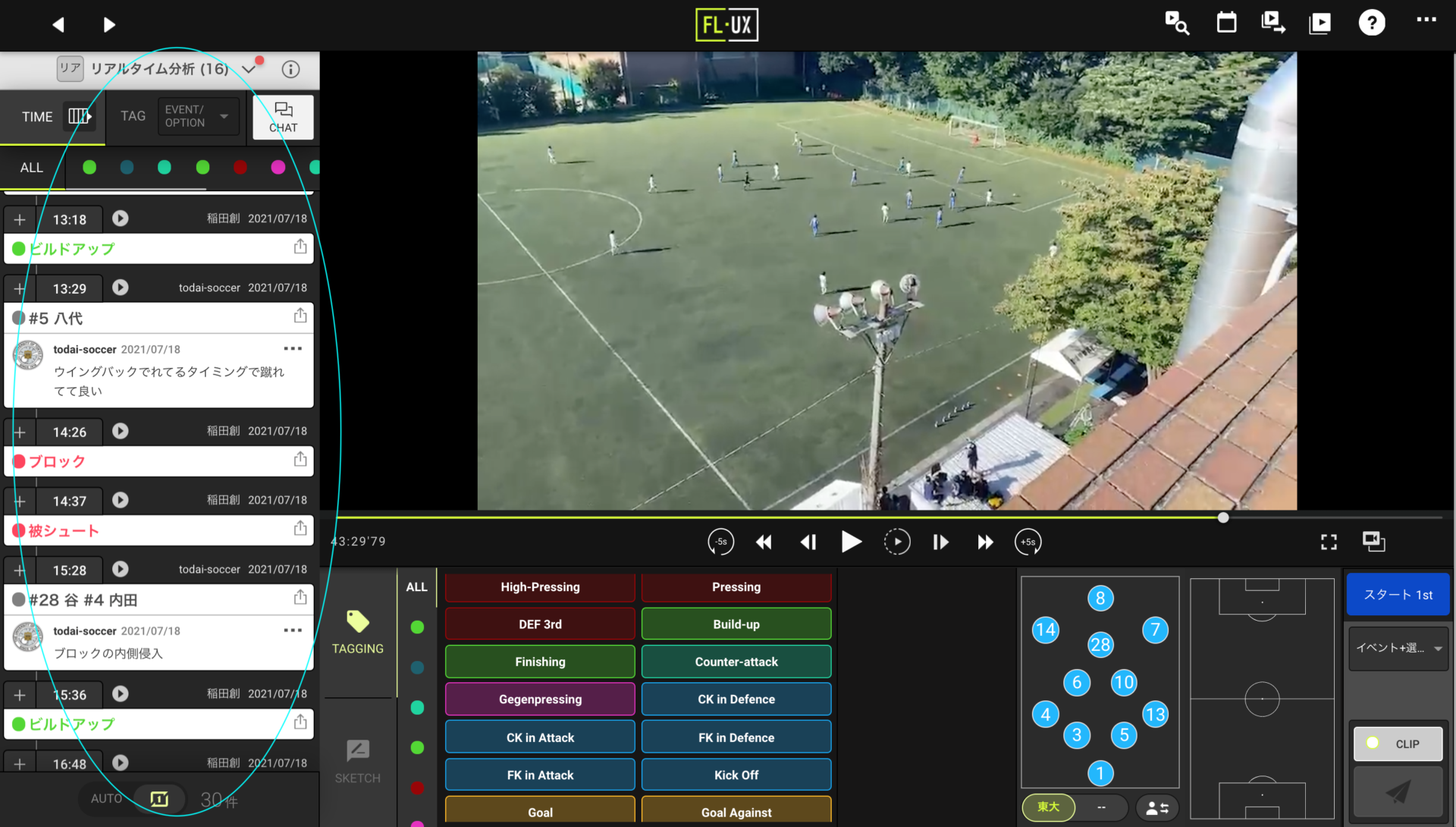
Although I can only disclose some of the actual qualitative analysis methods and feedback contents (circled in blue in the image above), there is no doubt that scouting is a prerequisite for analysis in particular. If your opponent does something very different from what you expected, you need to predict the game development macroscopically and present countermeasures within a limited time. In most cases, however, we have a game model, and we do not fundamentally change our approach 180 degrees during a game. We look at the more micro aspects of the game, such as where each player stands, how they hold the ball, and how they press. By halftime, we aim to have two or three points to correct as a whole, and one point for each player. At the moment, we have a large number of staff members, so we divide up the points to look at, but through these efforts, each technical staff member is working to improve his or her qualitative analysis skills, with the goal of eventually being able to conduct a high level of quantitative and qualitative analysis on his or her own.

Of course, it would be great to be able to go to the actual venue and analyze the game on site, but the number of people in attendance is often limited due to the new coronavirus infection countermeasures. In such cases, we gather in the club room with our own terminals and analyze the live images captured by FL-UX.

③On the bench
One of the most important is the technical staff on the bench. In your league, there are six staff members on the bench (including coaches and managers), and you are one of them, fighting alongside the players on the bench.

On the bench, I am on the phone with the technical staff who tag scenes that they want to show to the players as correction points according to the requests of the coaches and managers, and I tag them myself on the terminal. Then, from the many tagged scenes, I select the scenes that I want to show to the players as a whole, to a few players in the midfield or final line, or to individuals during water supply time or halftime. Therefore, not only qualitative analysis of soccer, but also accurate and speedy judgment and communication skills are required. Of course, it is essential to have all the information about the opponents, such as their tactics and the characteristics of the players to be replaced, and when we make a substitution, we may give detailed instructions, such as checking the markings for set plays. Therefore, the technical staff member who is most centrally in charge of scouting is basically responsible for this role.

For the future
At the time of writing this article, we have been doing real-time analysis for about two months now, and the technical staff is just getting used to it as they experience more and more matches. As a result, there are still areas for improvement and issues that need to be addressed in order to increase the team’s chances of victory by as much as 1% (training the eye for soccer is a prerequisite).
- Eliminate disruptions in live video due to Wi-Fi and communication devices.
- Have close discussions with the coaches in advance to predict the scenes that should be captured.
- Increase the number of scenes of the phase that the coaches want.
- Add supplementary information to all tags.
- Devise a color-coding system for the tags, and enhance the tags.
- Increase outreach to coaches and players.
- Improve presentation skills on the bench.
Also, at the end of the game, for example, there is no more feedback during the game, and tagging tends to be neglected due to the enthusiasm for the game, but it is necessary to carry out the task until the end to ensure seamless performance analysis after the game.
Below are some comments on the technical unit’s real-time analysis from coaches, managers and players.
Ryohei Hayashi Head Coach:
I think the number of teams doing this kind of analysis in J1 has been increasing recently, but when I was playing in the J-League, there was no such thing as real-time analysis using video. When I was playing in the J-League, there was no such thing as real-time analysis using video, and even more so, there were almost no university student teams that used it, so I think it’s a great approach, including the attitude of taking on such challenges.
Also, there are things that players cannot understand just from what they are seeing on the pitch, and it is very effective to be able to look back at the video footage later from a different perspective. I think it is also important for the technical staff to be able to tell the players at halftime what they have analyzed in real time, in addition to just being able to look back at the footage. We can see what scenes are reproducible, and the players can understand what is happening during the game, so I think it is beneficial for the team.
After all, it is great to be able to see the images from above. It is very different from the view from below, and I can see where the space is and how the opponents are pressing.
In the future, it would be a shame to be satisfied with just analyzing, and I think it is important to understand how to communicate this to the players. If I talk for too long, the players won’t understand what I’m saying, and it would be great if I could learn how to communicate in a short and easy-to-understand way.
Satoshi Yoshimoto OB Coach:
Basically, real-time analysis is used to fix things. We do not clip scenes in which our team is doing well.
If the opponent behaves differently than you scouted, or if they change their tactics during the game, it is easy to make errors, so be sure to clip them. Errors can also occur when there is not enough time to confirm the team’s principles of play in the preparation phase of practice, which often happens in overcrowded schedules. When this happens, I use the strategy board at halftime to explain it to the whole team, and then show them the video, which I think helps the players understand it better.
In terms of situations, due to our game model, we often cut out the build-up, middle press, and block defense.
We also use the video for personal errors. If there is a play that they are not good at, or if they make the same kind of mistake, it is often burned into their brains, so we prepare the video and try to solve it before the second half. In fact, some players have actually improved by doing this, so it is very useful.
Lastly, although it is called “real-time analysis,” it actually reminds me of the importance of prior preparation as well as on-the-spot decision-making. My impression after using it several times is that you can make the most of real-time analysis by communicating with the coach and the technical unit ahead of time, predicting possible developments to some extent, and having your team’s playing principles firmly in place.
Atsushi Oya (MF/3rd):
It’s been very well received by the players and I hope it will continue to be so. It is very common in soccer for the game to change dramatically at halftime, and I think this will be a major factor in improving the repeatability of the game. I think there are two major benefits of real-time analysis: 1) better interpretation of what is happening in the game and discovery of issues, and 2) better understanding of the players when giving them feedback.
(1) Because soccer is still complex, I think that using the brains of many of the technical staff in addition to the coaches on the bench will increase the number of issues discovered. There is a problem of how to select and communicate in the limited 15 minutes of half-time, but by increasing the absolute number in the first place, we will be able to select those. It’s a very good thing considering that there were many half-times before where people didn’t talk for the full 15 minutes.
It’s not uncommon for the players on the pitch to not fully understand or agree with the coach’s explanation on the board. If there is a video clip of the game, the players will be able to understand it better and change their play in the second half.
As a request, since the amount of feedback may vary from game to game, it would be good to have a quantitative goal, such as showing at least X scenes to each player every game.
Ryosuke Matsunami(MF/3rd):
To put it simply, I think it is a very powerful support. 90 minutes of soccer game is important to improve your play during the game, but it is not easy to actually improve during the game. It’s not easy to improve during a game, because you can only see your own play subjectively. Even advice from coaches and managers is only verbal, so in the end you can only digest it subjectively in your mind. On the other hand, with real-time analysis, you can actually see the video of your own play objectively, so I believe you can improve much more easily than if you do it only subjectively.

As you can see, the feedback we receive is very positive, and I feel that the Technical Unit needs to improve its performance to meet their expectations.
Another thing that I am finally going to try is quantitative analysis. We have already done some simple manual tallying, but we had stopped once for the reason that qualitative analysis would be neglected.
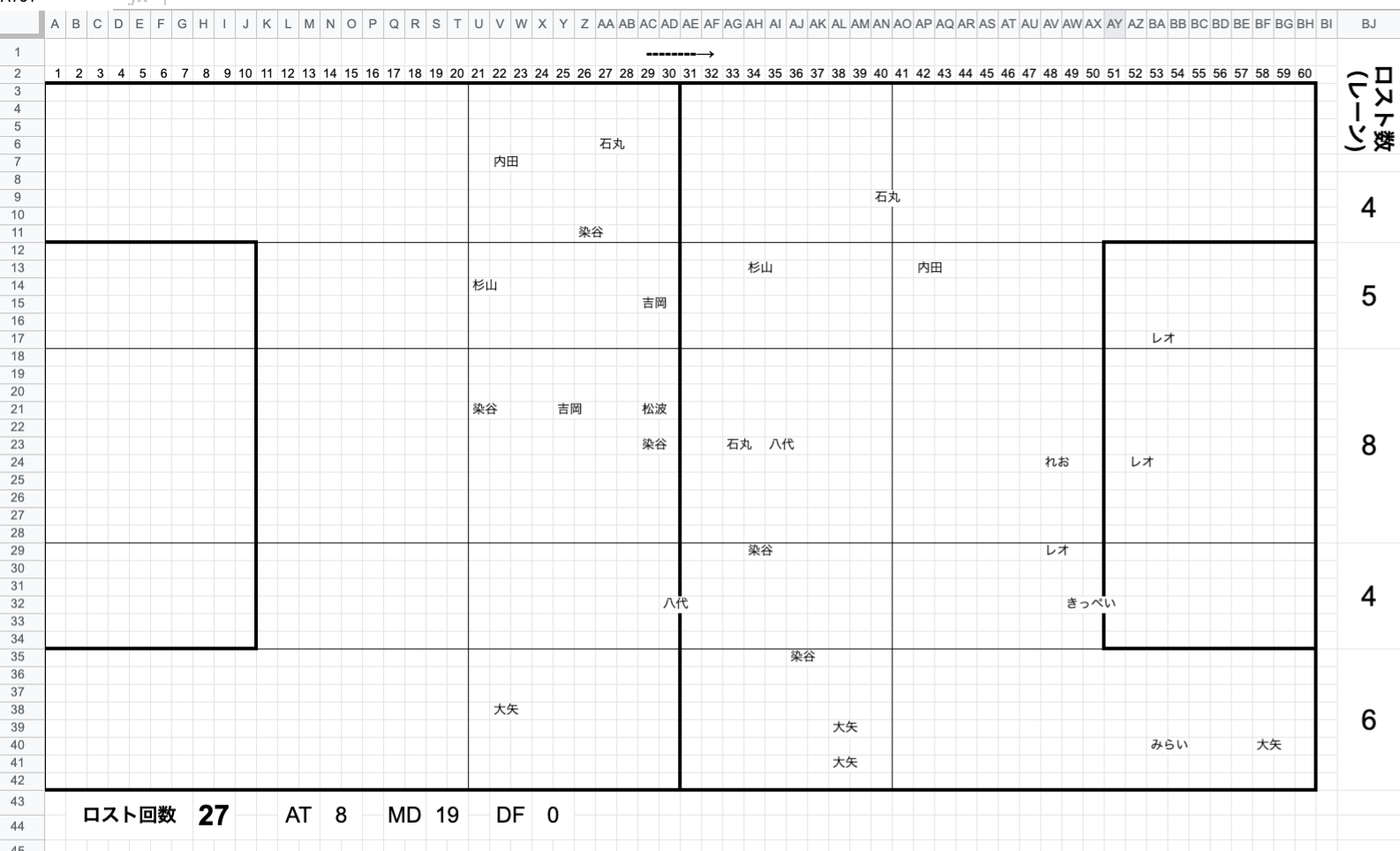
This is a tally of the ball-lost positions of my team. The difference between this and the top level of professional teams is that at the moment, we cannot use a system that can automatically give us effective indicators for our team in real time. Therefore, we need to think about how we can make use of FL-UX to perform manual counting (semi-automatically). More importantly, under such constraints, there is the question of what to quantify in the first place. I think it is important to quantify in terms of how well your team’s game model and principles of play are being realized, and how well you are executing your scouting of the opposing team and your game plan against them. The existence of a game model and a game plan means that there are criteria for points that need to be corrected. Indicators such as packing rate, xG, and PPDA, which can already be calculated and visualized in post-game performance analysis, as well as pass network diagrams (pass maps) (for details, see the article “Data Analysis of the A-Shiki 2021” with URL at the top of the page), are also important. It would be interesting to be able to quantify which areas and zones were used successfully or unsuccessfully, the vertical and horizontal compactness of the press, the success rate of the counterpressing, and the time it takes to win the ball back. I am eager to discuss these criteria again with the technical unit, coaches, and managers to create a situation where the entire team, including the players, can share the information and put it into practice.
On a related note, our Technical Unit has decided to install a new CATAPULT PlayerTek+.
This device will be worn by each player during the game to obtain various physical data such as heart rate, distance traveled, sprint distance, and maximum speed in real time. This data will also be used as part of the real-time quantitative analysis, especially in cooperation with the physical coaches who will be on the bench along with the technical staff.
Conclusion
With the goal of “becoming the best group of analysts in Japan,” the Technical Unit has continued to make advanced efforts in data analysis and other areas. We have just announced a partnership with the University of Tsukuba’s kicking team, and recently with FC Wacker Innsbruck of Austria’s second division. And now, we have introduced a new real-time analysis. The Technical Unit is grateful to be blessed with abundant resources and backup, and we will continue to do our best to take on cutting-edge initiatives that even professional soccer clubs cannot do. I hope that many people in the soccer world will pay attention to this project.

We are also always looking for students (regardless of university) who are interested in these activities. Please come talk to us, or contact us via Twitter or email!
Thank you for reading to the end!
Technical Staff, University of Tokyo Association Football Club
3rd year Keigo Kinoshita
